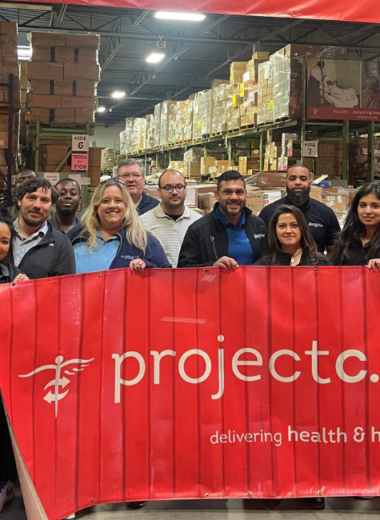
If you're a healthcare leader, the safety of staff members and patients is likely one of your top priorities. While healthcare-associated infections pose a huge threat to anyone who enters a hospital (including clinical staff) and warrants vigilant programs and procedures to reduce HAIs, slips, and falls might not necessarily be at the top of healthcare administrators' consciousness. Indeed, sometimes other risks that commonly cause harm or injury are underemphasized or overlooked.
In healthcare support services, one of the most common injuries associates experience are slips, trips, and falls. Since these are common injuries in support services, we’ve learned proper protocol and safety procedures to prevent these accidents from occurring and are equipped to help coach others, like the nursing team, to prevent injuries that could keep them from caring for patients.
With proper protocol and safety procedures in place, you’ll prevent nursing associates from injuries. Our safety experts weigh in on ways you can reduce slip and fall incidents in your facilities so you can more easily implement slip, trip, and fall prevention for healthcare workers.
What Is the Most Common Cause of Slips, Trips, and Falls?
Slips and falls happen due to a variety of frequent but easily avoidable situations in the hospital setting. Common causes of slips and falls in a hospital include:
- Wet floors
- Spills
- Messy work areas
- Poor visibility due to dim lighting
- Uneven flooring
- Poor drainage
In a clinical environment, spills and messes are bound to happen. Hospitals should be regularly sanitized and cleaned not just to reduce the risk of HAIs but also to reduce the risk of slips, trips, and falls.
How to Prevent Slips and Falls for Nurses
Here are some things we’ve learned to help keep teams safe. Try them out at your hospital to prevent slips and falls, especially for your hospital’s nurses.
Set Up Barriers Throughout the Hospital
Slips and falls happen all too often when nurses come in contact with wet floors. While you should always set up barriers when cleaning or repairing a section of the hospital, that alone is not enough. Some people believe wet-floor signs or safety cones are enough to alert people of potentially harmful areas. However, our experience tells a different story.
“Sometimes people leave floor signs up even after a floor has dried,” states Compass One Risk Manager, Judy Clark, who isn’t just referring to hospitals. Think of all the times you’ve visited a grocery store or shopping center that had wet-floor signs out, with no trace of an actual wet floor. “Since people are used to that, they ignore it.” Signs start becoming such a common piece of our daily awareness that we inadvertently ignore them, even when they really do warn of danger for slips and falls.
Because of this, it’s best to tape the entire area off as you clean to prevent people from brushing past a sign, accidentally entering an area, and slipping. Keep the area blocked off until you’re finished with repairing or cleaning, especially if you’re using strong chemicals. “Our goal is for no one to get hurt,” Clark states.
If you’re unable to tape certain areas off due to high volumes of people or last-minute cleaning, use wet-floor signs. However, understand that barriers are the preferred method of slip, trip, and fall prevention.
Use Signage to Notify Nurses of Upcoming Work
Another way to prevent slips and falls for nurses is to use signage to notify people of upcoming work. Hang signs to let people know if the floors in one wing of the hospital are going to be waxed on a certain day of the week. On that day, if you’re unable to block that section off, you can hang additional signage around the wing reminding everyone you’re waxing the floors.
If everyone knows of cleaning or repairs ahead of time, they will be aware of the areas they should try to avoid, if possible. If they can’t avoid the area, they can still take precautions to avoid accidents. Knowing ahead of time that work will be done can help nurses exercise the necessary caution when they come across these areas.
Communicate With Your Nursing Team Ahead of Time
How do you prevent slips, trips, and falls? Communication is key.
Communication goes beyond simple warning signs and advanced notice of work, though. One of the most crucial ways to reduce slips and falls is for support services and nursing teams to communicate clearly and collaborate. Make sure your hospital’s nurses and environmental services teams see themselves as part of the same team. Team-based care benefits patients, but a strong spirit of collaboration also benefits clinical staff who are safer when they are aware of scheduled repairs or cleaning.
Clark says if nurses don’t know what’s going on, that’s when you see a trickle-down effect of people falling.
Anytime you plan to clean or repair a large section of the hospital, keep your nursing team in the loop. Hospital leaders should encourage collaboration between support services and nursing. This allows the nursing team to weigh in on what times and locations are best to clean to prevent injury. Your nursing associates can make sure you’re working in certain sections aren’t as busy, which ensures you receive less traffic in that section of the hospital.
By creating an environment that fosters collaboration between nursing and environmental service teams, you create automatic opportunities for those teams to share knowledge and plans. The more nurses know about upcoming work — and the more they feel their needs are being considered when cleaning and maintenance are planned — the less likely they’ll be to accidentally come across an area that puts them in danger.
Additional Ways to Prevent Slips and Falls
Plenty of other practical ways to keep nurses from experiencing slips and falls exist. Other ways you can prevent your nursing team from slipping and falling include:
- Encouraging nurses to wear slip-resistant shoes.
- Keeping areas tidy by removing any items or objects from the hallway or walkways.
- Reporting any lighting problems to the maintenance team to help nurses clearly see where they’re going.
- Educating the nursing team on common safety procedures and policies.
- Calling EVS staff immediately after spills occur and making sure nurses know where basic cleaning supplies are if needed.
- Using cleaning products that don’t build up on the floors, causing them to be slippery.
- Placing water-absorbing mats in areas where water or other liquids could drip on the floor.
Again, a lot of these tips come down to one common theme: communication.
Tips to Effectively Communicate to Avoid Injuries
Nurses, of course, want to avoid slipping or falling. Furthermore, hospitals can leverage the practical knowledge nurses have to help improve everyone’s hospital experience.
The nursing team knows the ins and outs of a hospital. Healthcare leaders should encourage clinical and support services teams to attend each other’s meetings to discuss upcoming cleaning plans or requests. Chief nursing officers can help by communicating with EVS staff around when they expect certain floors to be slower. When clinical and non-clinical teams collaborate and communicate in this way, the hospital is safer for everyone. Instead of having different teams operating independently of one another, a collaborative environment allows all parties to draw on and learn from the knowledge the other possesses.
“It becomes a partnership,” Judy Clark explains. “If you can get through the communication and become partners, half the job is already done.”
Making sure nurses, patients, and hospital visitors feel safe in your facilities is an important responsibility. By listening to the concerns of your nursing team and making sure your hallways are clean and well-lit at all times, you can reduce the likelihood of attendees slipping or falling. Try to schedule your cleaning or maintenance ahead of time, and notify everyone of your upcoming plans so they can remain safe in your facility.
Related Posts
Let’s Talk About the Right Solution for Your Organization
Get in touch to discuss how Crothall Healthcare’s services and solutions can help your healthcare organization exceed its goals. You’ll learn more about:
- The transparency we bring to outsourced support services
- How we design customized solutions for your unique needs
- The technology and innovation Crothall delivers across all our services


